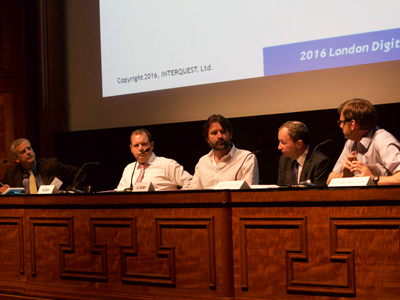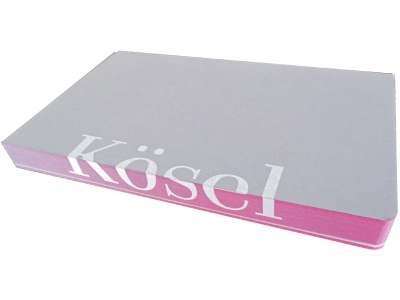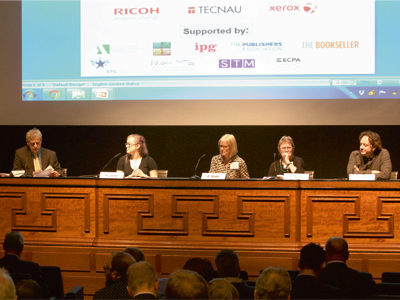Publishing panellists at Interquest’s 11th London Digital Book Printing Forum
Increased adoption of digital book printing shows no sign of slowing down as technology developments open up new opportunities.
Books are a booming market for digital print, which is expected to double its market share according to research from industry analyst Interquest. The firm’s figures for digital print in European book manufacturing predict a rise from 7% in 2015 to 14% in 2020. Key market trends identified by the study indicate that European book printers are making shorter print runs, doing more print on demand and moving to inkjet production. While digital printing is most commonly associated with monochrome work the research also showed a strong increase in colour work.
The proportion of digital printing that is colour doubled between 2011 and 2015 from 8% to 16%. Interestingly, sales of e-books have fallen by 2% in the UK since 2014. The smartphone and tablet-reading commuters have been usurped by traditionalists who prefer to hold a real book rather than a facsimile of one. Whether this drop-off has any correlation with the lack of new output from a certain, covertly-read EL James has yet to be verified (‘Grey’, the most recent instalment to the ‘Fifty Shades’ series was Kindle’s top pre-order book for 2015).
Interquest president Gilles Biscos revealed the firm’s latest research at its 11th London Digital Book Printing Forum, held at the Royal Institute of British Architects on 28 June. In other sessions, several in the form of panel discussions, players from across the book supply chain, including publishers, printers and equipment manufacturers discussed the trends, challenges and opportunities.
Booksellers
As part of the panel speaking on book publishing, distribution, and manufacturing, Richard Fidczuk, production director at scientific, technical and medical specialist Sage Publications explained that although most new titles are printed litho, some – mainly reference books – are done digitally. The company’s first digitally printed frontlist four-colour title was produced in March 2016 and the majority of Sage’s reprints are now digital (2010: 25% digital; 2015: 75% digital). The advantage, as Mr Fidczuk sees it, is that digital reduces risk, is more economic for 10-20 copy runs for niche titles, and keeps a broader catalogue of titles in print, including older editions. ‘Our books are always available,’ he stated. ‘We never put a book out of print any more.’

(L-R) Gilles Biscos, Interquest; Andy Cork, PrintonDemand; Arjen Jansen, Collins Learning; Eddi Oliver, Ashford and Richard Fidczuk, Sage Publications
Representing small and medium traditional book publishers, Anne Beech, managing director of Pluto Press reminded the audience that the UK market is still a challenge for small publishers with small budget; ‘margin is critical’ she stressed. Because of that 67% of books produced for the UK are printed overseas. The adoption of digital printing, which will bring the work back, looks to be a benefit both to publishers like Pluto Press and local printers. Ms Beech described her decision to start using digital as a ‘no-brainer’, particularly for the short runs, which comprise 90% of the firm’s list. ‘Digital printing is the hidden saviour of the small publisher,’ she pronounced. However, Ms Beech stated that the difference in quality – the look and feel of a product – can still be distinguished between digital and litho, although there has been ‘an increase in quality and appearance of digital,’ narrowing the gap.
Printers
A panel of printers discussed the production challenges they faced and outlined the areas for improvement. ‘The challenge is to keep as many books in print as possible,’ said Eddi Oliver, customer service director at Ashford Colour Press. Fast turnaround runs currently account for 89% of digital print volume, and it was stressed that while automation helps to facilitate a quicker turnaround time, an adequate interface is vital to ensure a smooth process.
Other issues for the panel included paper. An encouraging sign that digital is becoming more cost effective were reports that the price of digital inkjet paper is coming down. However it was highlighted that the preferred solution goes beyond a lower price for a specialist inkjet grade to being able to use the same paper for both long and short runs regardless of the print process employed. ‘Manufacturing techniques are critical’ and ‘inks are paramount,’ stated Andy Cork, managing director of PrintonDemand Worldwide. Echoing Ms Beech’s comments, he added that there is still work to be done on the quality of digital output because publishers demand quality that is close to litho.

German printer Kösel showed off its production prowess with ultra thin stocks and edge printing
Vendors
Fortunately for Ms Beech and Mr Cork, the session where digital printing equipment vendors discussed their drupa developments indicated that they are moving to meet these demands. Reinhold Frech, sales and marketing director, commercial printing group, Canon EMEA explained his company’s developments that allows printing on a wider variety of cost-effective papers, including standard uncoated and offset coated media. These included fast immobilising inks for the Océ ImageStream 3500 ink and its ColorGrip inline paper conditioning step. Such developments make it easier for printers to blend offset, toner and inkjet production without the need for different types of paper. This will be important as despite the rise of digital it will not usurp offset. The vendors highlighted that in the future, production processes will co-exist and complement each other. Benoit Chatelard, vice president, production printing business group, Ricoh, predicted that ‘offset will still be at drupa in 20 years’ time.’
Opportunities
Rounding off the day Gary Peeling, chief executive officer of Precision Printing talked about opportunities in publishing, focusing on applications for book personalisation and customisation. Mr Peeling stressed the need for quick turnarounds stating that the process is most effective when it can be achieved in eight hours in order to satisfy customer demand. He added that a logical progression for digital book printing is customised gifting and this, he believes, is ‘a huge opportunity for the publishing industry’ (see Signature Gifts case study on page 41).
The take aways from the event were that the book market is using digital print to its advantage and that the equipment vendors are working hard on developments to enable this to continue. There are also new applications emerging that could prove profitable to publishers and printers.





